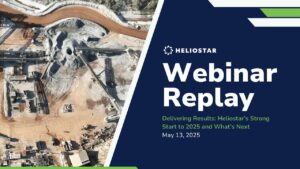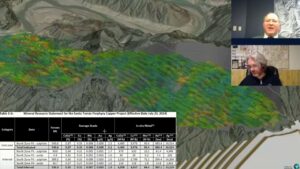
NUEVO BALSAS, Mexico — A road sign on the side of the highway alerts motorists that a steep decline lies ahead. It is a yellow diamond-shaped sign, and the figure of the motorist behind the wheel is riddled with gaping, rusted bullet holes.
A boy in a straw hat leads a donkey by a rope along the shoulder of the highway. Around a bend, three black vultures tear at a fresh piece of roadkill, reluctant to lumber away even as four shiny white trucks, moving together in a convoy, come roaring toward them. The first and last trucks are pickups, each with a machine gun mounted in its bed manned by a police officer. Each officer wears a black combat helmet, body armor, and polarized goggles.
The other two vehicles are white SUVs with tinted windows. They bear the logo of Minera Media Luna, a crescent moon above a thread of water, painted in gold on either side. Executives and contractors for this gold mining enterprise don’t feel safe traveling the remote highway without heavily armed escorts.
The gold mine that is their destination is an open-air dig high on the slope of a mountain, an immense mound of gray ash near the peak of a hill, a stark contrast to the forested hills beside it on the horizon. The operation has its headquarters about 30 minutes away in Nuevo Balsas, a town of about 1,300 people on a big man-made lake nestled among the hills of Guerrero, the troubled Mexican state where drug lords and corruption are the order of the day. The now-infamous town of Iguala, where 43 students went missing last September, lies about 35 minutes, and more than an hour’s drive, to the north.
A shrine to the Virgin of Guadalupeenclosed in a glass case announces the entrance to Nuevo Balsas. The town begins where the highway ends. The road narrows and the pavement starts to crack and crumble.Torex Gold Resources, the Toronto-based company that owns Media Luna, estimates that the site holds 5.84 million “gold equivalent ounces.” At the current price of $1,200 an ounce, that would place the mine’s value in the neighborhood of $7 billion.
Several dozen men and boys carrying bolt-action rifles and shotguns wave me down.
“Identification, please.”
These are the community police of Nuevo Balsas, residents of the mining town, and they have installed this checkpoint as a security measure.
On February 6, a criminal cell in league with La Familia Michoacana, a mafia based in a neighboring state, ambushed passengers in one of the Volkswagen vans that cart passengers back and forth to Iguala at a charge of less than 2 dollars. The assailants were 30 in all, armed to the teeth, and disguised as soldiers.
The kidnap victims were mine laborers, a woman custodian, and a contractor from Sinaloa. Six fishermen were kidnapped as well from where they stood on the bank of the Río Balsas.
In all, 13 men and women were abducted, including five who worked at the mine. One captive was set free to deliver a message to the community police: “Tell themLa Burra is back.”
Now the sun is at its apex over the Nuevo Balsas checkpoing, and most of the men and boys squat in the sparse shade beside the road. They wear jeans, dusty leather sandals, and straw hats. A dozen women and children huddle beneath a tarp nearby.
Most of these men and boys are fishermen. About half the working-age males in Nuevo Balsas have made their living off the lake at one time or another. Before construction of the mine started a decade ago, Nuevo Balsas was a fishing village. Now everything, including the fishing, is on hold as the community searches for ways to respond to the kidnappings.
As word spread of what had happened, more than 300 men from Nuevo Balsas, La Fundición, Real del Limón, and Atzcala grabbed the nearest rifle or pistol and formed search parties to comb the hills for the disappeared. They also closed the mine—por palabra, “by word of mouth”—pending a successful rescue.
They complain that the state and federal government, and the mine executives, were slow to react to news of the kidnapping, now a month ago. The 27th Infantry Battalion, which was stationed in Iguala after the disappearances there, did not set up a checkpoint on the only road out of town nor coordinate with the search-and-rescue efforts until 24 hours had passed. Neither did the Federal Police.
La Media Luna, for its part, sought to minimize its own stake in the crisis. Gabriela Sánchez, a spokeswoman for Torex Gold Resources, denied that several mine employees were among the kidnapped. She said only one of the kidnap victims was an actual employee. The mine, she said, would continue to operate according to schedule.
Not until the community volunteers had closed the mine did the first soldiers and the first SWAT teams arrive to assist the search. And even then, the residents say, the military and police stayed in their vehicles while the volunteers went off to search the hills on foot.
The community volunteers managed to rescue 10 of the 12 kidnap victims within 48 hours. Witnesses describe the newly freed captives as trembling with shock, severe dehydration, and fatigue. One of them, Mario Bahena Aguilar, a mine worker, had been shot in the leg as he wrestled his captor to the ground. His fellow captives eventually overpowered the gunmen.
Later, when the army interviewed the rescued captives, at least five identified themselves as contractors, laborers, or maintenance workers at La Media Luna gold mine. The remaining two victims were not found, and the presumed ringleader of the crime, Uriel Vences Delgado, alias La Burra (a female donkey), evaded capture.
Tomás is the comandante in charge of the checkpoint at the entry to town. He is a short and stocky man in his 40s with a paintbrush mustache and a straw hat whose brim is as broad as his shoulders. In civilian life, Tomás is a baker, and he used the double-wide brim of his sombrero to tote his bread around town.
Gold fever has converted Nuevo Balsas into a boomtown of sorts, he says. The old dirt-and-gravel track into town is now a paved road. The ramshackle living quarters for rent downtown are remodeled and repainted. A warehouse, laboratory, and a cellphone tower have been built.
Cases of malnutrition have diminished, while employment and income are on the rise. But pollution, illnesses, and crime are new problems. Tomás said the government foresaw the economic growth, but failed to anticipate the problems associated with the growth, above all an increase in crime.
Speaking reasonably of the mine owners, Tomás said “No one agrees with anything that harms their interests. That is a normal response. If someone were affecting my interests I wouldn’t like it either.
“We aren’t in the habit of fighting them,” he said. “It’s just that at the moment they’re losing money and they don’t understand. But we’ve suffered losses, too. We’ve lost our two compañeros. So, they don’t have the moral high ground this time.”
This is not the first wave of kidnappings or violence to strike the area of La Media Luna. As many as 30 kidnappings and four murders occurred in the first two weeks of December 2013, and that sparked the beginning of the region’s self-defense operations.
The community police, which formed up on December 13, 2013, saw their action as an obvious necessity. There are no local cops in the area, and state police do not patrol it either. La Media Luna hires a private security detail of 70 state police, but the police do not intervene in matters that do not directly influence the interests of the investment.
Members of the new force determined that La Burra, a native of Nuevo Balsas, was behind the violence. They drove him and his family out of Nuevo Balsas. The rumor was that he was killed. Then came the rash of kidnappings on February 6 and the messages that came with it. La Burra was acting as the pointman for La Familia.
“It’s La Familia Michoacana,” one of the comandantes explained. “It’s a mafia, and they know there is a mine here, that they’re opening a gold mine, that there is a significant investment of money. He isn’t so much interested in drugs. He is interested in money.”
The leaders of the community police have known La Burra since he was a child. Even the elders who were raised here and have spent a lifetime among these hills regard him as a kind of bogeyman. Local legend has it he once hiked alone through the mountains from Morelos to here in six nights. In a photo the community police show to visitors, he has fair skin, a wiry build, and wears a brunette wig, red lipstick, and a slim fitted white gown with a halter neckline. They say he can also pass through a crowd unnoticed in the guise of an elderly man.
The community police publicly charged that La Burra extorted the transnational gold mine to the tune of $70,000 a month for “protection.” They also charged that the regional boss of La Familia, a man who ranks above La Burra, owns a company that does subcontracting for the gold mine.
La Media Luna printed a full public denial of the allegations in an advertisement it took out in a local newspaper.
Work at La Media Luna gold mine had ground to a halt four days ago.Only the mine’s security personnel remained active. So, on a concrete basketball court in the middle of Nuevo Balsas, 20 mine workers were playing soccer. The losing team would buy beer for the winners. Their fluorescent orange mesh vests were strewn on the dirt at the edge of the court.
They were men of all ages and sorts, old and young, tall and short, long hair and buzz cuts. Many of them had come hundreds of miles to work at the mine, from states as far away as Chiapas, Chihuahua, Durango, and Veracruz. They raced around the soccer court in faded T-shirts and tattered sneakers.
Among the group of a dozen spectators was a construction worker who kept his hair tied back in a ponytail. A Virgin of Guadalupe tattoo covered his forearm. He said he was part of a work crew that operates the rock breakers and the crushers. They work 11-hour days, six-day weeks, for $100 pay.
The crew is mostly in the dark about what is happening. They know that they were at breakfast as usual one morning, and that instead of being driven to the mine, they were brought back to the dorms, and that a manager informed them that the mine was temporarily closed.
“We don’t know if we’re being paid, we don’t know anything,” said the man with the ponytail and the Virgin on his arm.
Up the street, the Media Luna headquarters occupies the length of a block in a one-story white cuboid with bars on the windows. A fleet of white pickups, SUVs, and extra-large vans lines the road out front.
A security guard opens the reinforced iron door to the office, but keeps the security gate in front of it locked. A breeze of cool air wafts through the grating. The mine’s press spokesman is away, and the guard says he doesn’t know when or if he will be back.
On the opposite end of town, the pavement gives out and a chalky track leads into the hills in the direction of the villages of La Fundición, Real del Limón, and Atzcala.
On the other side of the Río Balsas, the community police are gathered in a group of more than a hundred for lunch and a moment of rest. A comandante by the name of Marcos is in charge. He and his men are in high spirits because two state police patrols have been alongside them all day as they’ve been working their way through the hills.
The state police are quiet, and stand together off to the side. The community police outnumber them 12-to-1.
Marcos is relating the highlight of the day pursuing La Burra and his men:
“We found tracks in a ravine where we believed they stopped to rest,” Marcos said. “They stopped there to camp. They smoked cigarettes. We found cigarette butts.”
The tracks diverged, however, and they lost him. “But he is close. And he is hiding up there.”
The men happen to be gathered in front of a property with a house in ruins that used to belong to La Burra.
Marcos says the Mexican Army’s 27th Battalion withdrew its roadblock from this place after the kidnap victims were rescued, and has otherwise ceased aiding the search for the two still missing. An army helicopter made the briefest of appearances, being grounded immediately for a mechanical issue.
“I’m not here to blame the army,” Marcos said. “I don’t know the reason, maybe they need to go through a lot of red tape. I don’t know what the situation is. But I have seen before when a man was shot, about two years ago, and the helicopter came immediately.”
“When all is said and done, the lives of two people are at stake, and their disappearance saddens us,” said Marcos. “We miss them. And we feel what they must be feeling. And it is painful.”
Five days later, the community police in Nuevo Balsas were in a somber mood. They had been unable to find the two remaining kidnap victims, and they feared that La Burra has slipped through their fingers.
Government support was on the wane. The army was nowhere to be seen, and state police withdrew without explanation, leaving the volunteers to conduct the search on their own.
Comandante David, a large man with a hunting rifle strapped across his back, wore a rueful expression. In a show of goodwill, he and his men agreed to permit La Media Luna to resume operations for a trial period. He was taking a wait-and-see approach to the meeting convened by a peace negotiator from the state government. It was the second such meeting since the crisis began.
La Media Luna hosted the get-together in an air-conditioned building in town. Several important officials sat at a long table at the front of the room: a mid-level officer in the state government, a gold mine executive, a criminal prosecutor from the state, and the private secretary of the mayor of nearby Cocula.
The community police occupied the fourth and fifth rows of folding chairs, holding their hunting rifles and shotguns. The emissary from the state government opened the meeting by reading aloud from the terms of a proposal the state government had drawn up. The preamble endorsed the coordinated search-and-rescue efforts of the previous week, but bogged down in concerns over the legality of the community police.
The 27th Infantry Battalion did not send a representative to the meeting, but relayed a message through the state emissary that the community police are operating outside the law, and must either disarm or comply with the government protocol to become legally recognized as Rural Police.
The men in the fourth and fifth rows sat with their arms folded and listen to the protocol of arms training, anti-corruption testing, uniforms, boots. They did not look pleased. One after another, they interjected comments that drowned out the voice of the state emissary.
“You treat us like we’re the criminals.”
“We wouldn’t be here if the government was doing its part.”
Comandante David interpreted the protocol as an implied threat that he and his men must disarm.
“We’re living through the problems that for you are points for discussion,” said one man, an elderly teacher in the front row.
The commotion built up, making it difficult for the reading to continue. The audience interrupted every few seconds, in an effort to shift the focus of the discussion to the search and the crisis of public safety in the area: How many state police will be assigned to the search? Why did the state police withdraw? Will the state police have a presence in the towns of La Media Luna? Will the mine pay for repairs to a few trucks damaged during the search and manhunt?
“The only vehicle the community police have in Atzcala is broken down. We've been patrolling on foot for the past five days.”
“There is no security. There is no government in Limones.”
“You tell us to wait. We don’t have the luxury. The criminals aren’t waiting.”
“If it were a mine executive who was kidnapped, how different would the response be?”
Comandante David got up and walked out. People began to gather in the street. Did David think the people would permit the mine to reopen? “They might not even let these officials leave town,” he said.
The crowd started pouring into the meeting. The speakers’ table had to be pushed back to the wall to make room. Then the people in the hallway began to bang on the walls, demanding the meeting be moved outside. The meeting was moved outside.
The mine executive from La Media Luna, C. David Alduenda Farias, stood before the crowd, waiting for the state emissary to regain control over the proceedings. (“Who are you?” an elderly man with a walking cane demand of the state negotiator. “Here the custom is to identify yourself to the people you intend to address.”)
Does La Media Luna have a responsibility to ensure public safety in the towns from which it is extracting gold?
“The safety of the town is the responsibility of the government,” says the Media Luna rep. “It is not our responsibility. We are willing to work with the government.”
Night falls but the crowd remains where it is. The meeting is entering its fifth hour. A new joint agreement is read to the assembled crowd under the light of a streetlamp:
The state prosecutor's office will issue an immediate warrant for the arrest of Uriel Vences Delgado, alias La Burra, for kidnapping. The community police will consider submitting to the legal protocol to legalize their existence as Rural Police. The county seat will send tow trucks for the damaged vehicles, and the mining company will pay for immediate repairs. Ten state police officers in two patrol vehicles will return to Nuevo Balsas in the morning to resume the search. The mining company will provide a schedule of the departures of armed convoys and encourage the townspeople to take advantage of the public safety benefit.
The issues of regular state police patrols and a permanent army presence in town will be tabled until a future date.
Comandante Marcos makes the briefest of victory speeches, and cedes the limelight to the elderly teacher, who paints the agreement as a new day in the history of the relationship between the mine and the town.
Comandante Tomás appears jubilant at the turn of events, which he likens to an anthill’s being kicked over. To keep the town safe and pressure the state government to act, he says, they had to close the mine.
“We’re short on the funds necessary to have what the mine has,” says Tomás. “We lack the means. Basically, we’re poor, in that sense. And since we’re poor we have to look for ways to defend ourselves and find a bit of peace.”
How long that will last in the mountains of Guerrero is anybody’s guess.
Original Article: http://www.thedailybeast.com/articles/2015/03/09/mexican-vigilante-justice-hits-7-billion-gold-mine.html

















